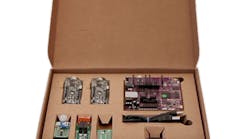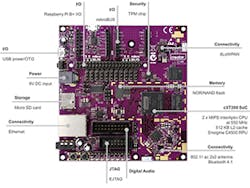The Internet of Things is growing exponentially each year, with the number of connected devices expected to reach 4 billion in 2016. When it starts shipping in April, the Creator Ci40 IoT kit will offer developers wanting to quickly and easily prototype an IoT-enabled device the hardware, software and cloud connectivity to add to this number. The modular package includes a development board that integrates a 550 MHz dualcore, dual-threaded MIPS CPU, two MikroElektronika Clicker boards with a dedicated 6LoWPAN chip, and three sensors for measuring temperature, detecting motion and controlling relays. Imagination Technologies recently funded in part through a Kickstarter campaign. Paul Evans, the company’s senior business development manager, explains why this wireless kit was developed, how Kickstarter generated buzz and who should be counting the days until its April release
Why did Imagination develop this IoT kit?
Creator Ci40 Developer Board
We’ve been involved in a number of IoT projects, for Silicone IP to the media tech companies of the world. Every time we approached a new project, it seemed like we were starting from the fresh. We could see various kits coming into the marketplace, but some of them didn’t even have wireless connectivity and really didn’t give us a broad generic platform. We asked ourselves, “What would we actually want here from a generic platform?” We put together this IoT hub called Ci40, which has Ethernet on it, and also the wireless standards you’d expect from home automation type things, like WiFi and Bluetooth. To make this board cost effective and also give it its broadest range, we put on MicroElectronika interfaces that allow people to plug in other modules, like GSM modules to connect to the cellular network. By having those interfaces, people can mix and match. There are over 100 sensors available: Alcohol detection, nitrogen, humidity, and many more.
What does it really do?
It provides the hardware and software. We have a cloud service called Flow Cloud that connects all the bits and pieces. From there you can start to analyze what’s going on and get your data from all the different sensors. With the device management element, you can control from cloud and interrogate it. Which version of firmware are you one? How much battery power do you have left? That all comes in the kit. So when people want to get started, they can just pick up the kit, and plug things together. Here’s the software frame and you’ve got the connection to the cloud. Very quickly they have an IoT setup and they’re ready to start developing on top of that.
We don’t have final pricing at the moment, but we have separated the hardware and cloud. You get five connected devices for free. If you have 10 or 1,000 devices, we will have a subscription you can pay monthly on line. We really are there for people who want to expand into an actual business or solution and they can progress with our plan, with 100 devices, a thousand, or a million
How is the security?
When people talk about IoT, one of the big issues is security. Whatever the weakest link is, usually the cheapest point, is going to be the thing that can be attacked. We had lots of discussions around security. One thing we put in is TPM chip, which has keys kept in there to do secure boots.
Creator was funded in part through a Kickstarter campaign that generated more than $46,000 from 376 backers. Besides the money, what are some other benefits from Kickstarter?
Historically, we were a B2B, selling silicone IP. Selling a kit or a board was a very new area for us. We weren’t sure about it so we discussed the different ways we could launch. We wanted to test what people were interested in it, so we treated it as a Kickstarter. We put out why we believed in it and were able to see if the market saw the same thing. The feedback element is really useful. You can see where that traffic came from, from an email blast or a particular article. You definitely get a picture of where the audience is coming from
Oftentimes, creators sometimes think they have a good idea, but it’s not until you get it out to market you discover people kind of like it, but if you tweak it, it will be much better. That process is very rewarding and a lot of work. People must not be too precious about their concept.












